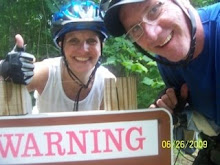




(Natchez Trace, TN: 5 May 2010) Lewis and Clark were heroes of mine when I was growing up in the Pacific Northwest. The story of their leading the Corps of Discovery (a military expedition) across the continent in the early 1800s is legendary. I read Stephen Ambrose's book, Undaunted Courage, a few years back and appreciate even more what they accomplished on their Oregon Journey. What is not so well known is what happens later.
The Natchez Trace is possibly the oldest continuously used road on the entire continent of North America. There is now a beautiful parkway, sometimes following the old trace exactly, often the old trace is close by, for 444 miles from Natchez, MS in the south to Franklin, TN, just outside Nashville, in the north. From animal trail to Indian trail to merchant trail, this has been an important route for centuries. We are not driving the whole trace. We have a camp 1/2 mile from the parkway near the 380 mile post, about 5 miles from the Meriwether Lewis Death & Burial Site. After the Expedition, Lewis was appointed governor of the Louisiana Territory and settled in St Louis. In Oct 1809 after coming partway down the Mississippi River from St Louis he was traveling overland on the Natchez Trace on his way to Washington to address issues regarding denials of payment for charges he made to the War Department as governor. He stopped at Grinder's Stand (an inn) for the night. Gunshots awoke the innkeeper during the night. Lewis died after sunrise of multiple gunshot wounds. Some think he was depressed and committed suicide. Some think he was shot when someone tried to rob him of the valuable journals of the expedition he was carrying with him in hopes of going on to Philadelphia to work with an editor to prepare the journals for publication. His death is still a great mystery.
We actually hiked around the area and finished the last mile of the hike down the Old Trace into the area where Grinders Stand was (a replica is there today) just as Lewis would have over 200 years ago.




No comments:
Post a Comment